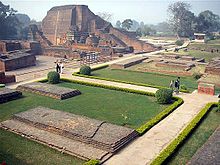
Back تراجع البوذية في شبه القارة الهندية Arabic ভারতীয় উপমহাদেশে বৌদ্ধধর্মের অবনতি Bengali/Bangla Déclin du bouddhisme en Inde French भारत में बौद्ध धर्म का पतन Hindi Kehancuran agama Buddha di India ID Declino del buddismo in India Italian インドにおける仏教の衰退 Japanese การเสื่อมถอยของศาสนาพุทธในอนุทวีปอินเดีย Thai Suy tàn của Phật giáo ở tiểu lục địa Ấn Độ Vietnamese 佛教在印度的衰落 Chinese

| Part of a series on |
| Buddhism |
|---|
 |
Buddhism, which originated in India, gradually dwindled and was replaced by approximately the 12th century.[2][3] According to Lars Fogelin, this was "not a singular event, with a singular cause; it was a centuries-long process."[4]
The decline of Buddhism in the Indian subcontinent coincides with the spread of Islam in that part of the world, especially due to the Islamic invasions that occurred in the late 12th century.[5] Another factor was invasions of north India by various groups such as Indo-Iranian Huns, Hephthalite Huns, Alchon Huns, Turco-Mongols, Arabs, and Persians, and subsequent Islamic destruction of Buddhist temples, shrines, and institutions, such as the Taxila and Nalanda universities, and religious persecutions.[6] Religious competition with other Indic religions like Hinduism and later Islam were also important factors. The persecution by the Alchon Huns in the 5th century and subsequent destruction of Buddhist centres caused the decline of Buddhism in the northwestern regions of the Indian subcontinent.[7] A similar process occurred in northeast, where Islamization of Bengal and demolitions of Nalanda, Odantapuri, and Vikramashila by Muhammad bin Bakhtiyar Khalji, a general of the Delhi Sultanate, are thought to have severely weakened the practice of Buddhism in East India where it previously received strong patronage under the Pala Empire.[8]
The total Buddhist population in 2010 in the Indian subcontinent – excluding that of Sri Lanka, Bhutan (both Buddhist majority states), and Nepal – was about 10 million, of which about 7.2% lived in Bangladesh, 92.5% in India, and 0.2% in Pakistan.[9]
- ^ Scharfe, Hartmut (2002). "From Monasteries to Universities". Education in Ancient India. Brill’s Handbook of Oriental Studies, Section 2: South Asia. Vol. 16. Leiden and Boston: Brill Publishers. pp. 144–145. doi:10.1163/9789047401476_010. ISBN 978-90-47-40147-6. ISSN 0169-9377. LCCN 2002018456.
- ^ Akira Hirakawa; Paul Groner (1993). A History of Indian Buddhism: From Śākyamuni to Early has been Mahāyāna. Motilal Banarsidass. pp. 227–240. ISBN 978-81-208-0955-0.
- ^ Damien Keown (2004). A Dictionary of Buddhism. Oxford University Press. pp. 208–209. ISBN 978-0-19-157917-2.
- ^ Fogelin 2015, p. 218.
- ^ "Citation Needed", Retcon Game, University Press of Mississippi, 3 April 2017, retrieved 3 March 2024
- ^ Cite error: The named reference
Merriam155was invoked but never defined (see the help page). - ^ Ghosh, Amalananda (1965). Taxila. CUP Archive. p. 791.
- ^ Hartmut Scharfe (2002). Handbook of Oriental Studies. BRILL. p. 150. ISBN 90-04-12556-6.
Nalanda, together with the colleges at Vikramasila and Odantapuri, suffered gravely during the conquest of Bihar by the Muslim general Muhammad Bhakhtiyar Khalji between A.D. 1197 and 1206, and many monks were killed or forced to flee.
- ^ Religion population totals in 2010 by Country Archived 25 March 2018 at the Wayback Machine Pew Research, Washington DC (2012)
© MMXXIII Rich X Search. We shall prevail. All rights reserved. Rich X Search